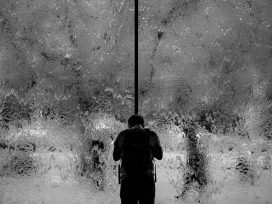
Loneliness is a growing health crisis, and gender norms make men more vulnerable to digitized isolation. An ever-more frictionless online experience erodes young people’s capacity to tolerate frustration and establish lasting ties.
Women have been as vociferous as men in the Egyptian revolution. However their demands for an end to sexual discrimination are not universally respected. Is a new revolutionary patriarchy emerging in Egypt like in Iran after 1979?
I travelled to Cairo despite of my family’s protests. They were worried about my security. But I wanted to experience again the feeling of celebrating a revolution.
My old home country, Iran, experienced a revolution 32 years ago. Just like today’s young people in Egypt, we thirsted for freedom. But the Shah, like Mubarak in Egypt, would not accept giving way to our demands. So revolt and subversion became the only way.
I arrived late at night, went to bed but awoke after just a couple of hours sleep. I wanted to be at the place everybody was talking about, Midan Al-Tahrir, Liberation Square. Tahrir broke the stereotype. The repressed, submissive and ignorant Arab woman turned out to be a rebel. She took part in the revolution, worked as a doctor in the temporary hospital in the middle of the Square, as an organizer in the tents, as a writer, journalist and photographer documenting the revolution. In the clashes with the police she shouted: “The people of Egypt are not afraid. Come and arrest me if you dare!” And she roused the people when she shouted, from her heart: “Come to Tahrir if you are brave, and if you love Egypt!”
I saw all types of women, wearing both shawls and crosses, sophisticated and simple, younger and older. “Did you know that there were twelve women among those killed by the security forces during the revolution? And do you know our brave Shahira Amin?” a young student asked me. She was referring to the female television anchor who jumped from her car at Tahrir on her way to the TV studio to join the demonstrators.
Evening was approaching. The women were still there, at the Square. Many had slept there, lived there for several weeks, going home only to take a shower and change their clothes. I sat myself down in a ring of people outside a tent and listened to the discussion. I could understand a few words here and there. Then I was helped by a couple of women who could translate for me. They were discussing whether the constitution should be changed through a referendum or be rewritten entirely. Whether parliamentary elections should first be held and then the presidential elections – or the other way around?
Someone was playing the tabla just a few steps away from us. A Jordanian woman sitting beside me clapped her hands in time and sang along with the others; it was a jingle that had arisen collectively, night after night, while people sat in their tents, as a way to pass the time and to encourage each other. The words were changed and new words were added, depending on what happened during the day. The Jordanian women was visiting a female friend in Cairo. “It is important to be present in the historical course of events. I am going to take the story of Tahrir home with me,” she said, tears in her eyes.
Several womens’ organizations had combined to take part. They had plans to mobilize a million women on International Woman’s Day, 8 March. In previous years, meetings and seminars had been arranged by Mubarak’s wife, Suzanne, who chaired a large state-run woman’s organization. That was also the case in Iran in the time of the Shah. Then there was a women’s organization headed by the Shah’s twin sister Ashraf. Dictators who find that women demand different rights will create women’s organizations led by women belonging to their own family. At best they function as charitable institutions.
Now was the first time that the women of Egypt would celebrate Women’s Day as free citizens. They wished to see the end of sexual harassment and demanded equal rights. A couple of hundred women and men assembled with placards and banderols outside the journalists trade union’s building, preparing to march through the commercial quarter to Tahrir Square. There the women met the masses. Lively discussions started up. I walked around and listened to the voices, which became louder, and saw how the body language became more and more aggressive. It felt familiar. The women were being accused of supporting Mubarak. “What is it you really want? It is not yet time for separate demands. You must not destroy the unity in the country.”
The women explained that a woman may also become president, that women should be represented in the transitional government and in the committee formed to assess the constitution.
More people arrived at the Square. They were different from those I’d seen here before: badly dressed, many in rags. They became more and more impatient, especially when they saw veiled women arguing in the same way as women in jeans.
A couple of hours later the hooligans had surrounded the women, verbally abusing them, accosting them and chasing them from the Square. Among the few women who remained was a young girl, who with a bitter smile commented to a journalist beside me: “This is a patriarchal society, we have a long fight ahead of us.”
That day reminded me of 8 March 1979 in Teheran. Iranian women also took part in the battle against the dictatorship, fought as guerrilla soldiers and landed in prison, where many died under torture. When time came to throw the out the Shah, the women actively took part. But the revolution of 1979, which wished to exchange a despotic monarchy for a democratic republic, was kidnapped by the mullahs, who as soon as they had gained power started discriminating against women. One dictatorship had been replaced by another.
The first thing the Islamists did was to force women to wear the veil. Just a month after the take-over, a mullah appeared on state television condemning the celebration and declared: “The Shah’s politics turned women into dolls. They dress seductively and indecently. They must use veils.” Iranian women had been planning to celebrate International Women’s Day in public for the first time the next day. Before then they had only been able to celebrate in secret, the Shah having branded the celebration “communist”.
On 8 March 1979, the streets of Teheran were filled by tens of thousands of angry women protesting against the regime. “We do not wish to be obliged to wear the veil”; “In this spring of freedom, women’s rights are lacking”; “We demand equal rights”; “We did not start a revolution so as to go back in time.” These slogans were shouted in the streets of Teheran for three days. Then the government’s troops moved in with tear gas, and their lackeys, dressed in civilian clothing, drove us from the squares and streets with cudgels and chains.
Then everything happened at great speed. Government institutions refused to serve unveiled women, taxi and bus drivers who allowed them on board were fined, shops refused to serve them. Notices were put up outside shops saying, “women without veils are not welcome”. Iran became a country where the state decides how much of the female body may be seen in public.
I stood at the Tahrir Square and wondered if this attack on the women might be the beginning of something similar to what happened to the women of Iran. The people dressed in rags seemed to be the same sort as those who attacked us in Teheran, on Woman’s Day in 1979. I sincerely hope that my misgivings about the Islamists do not come true. Maybe the Egyptians of today are better informed than we were three decades ago.
Published 13 April 2011
Original in Swedish
First published by Svenska Dagbladet 27 March 2011 (Swedish version); Eurozine (English version)
© Azar Mahloujian / Eurozine
PDF/PRINTSubscribe to know what’s worth thinking about.

Loneliness is a growing health crisis, and gender norms make men more vulnerable to digitized isolation. An ever-more frictionless online experience erodes young people’s capacity to tolerate frustration and establish lasting ties.

Second-wave feminist concerns over violence to women led to intense disagreement over pornography. For some, sexually explicit content was inherently abusive. Others explored the potential of what became sex positivity. Vox Feminae charts the emergence of US lesbian BDSM magazines from the late 1970s.